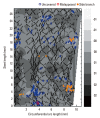Stent evaluation with optical coherence tomography
- PMID: 23918554
- PMCID: PMC3743208
- DOI: 10.3349/ymj.2013.54.5.1075
Stent evaluation with optical coherence tomography
Abstract
Optical coherence tomography (OCT) has been recently applied to investigate coronary artery disease in interventional cardiology. Compared to intravascular ultrasound, OCT is able to visualize various vascular structures more clearly with higher resolution. Several validation studies have shown that OCT is more accurate in evaluating neointimal tissue after coronary stent implantation than intravascular ultrasound. Novel findings on OCT evaluation include the detection of strut coverage and the characterization of neointimal tissue in an in-vivo setting. In a previous study, neointimal healing of stent strut was pathologically the most important factor associated with stent thrombosis, a fatal complication, in patients treated with drug-eluting stent (DES). Recently, OCT-defined coverage of a stent strut was proposed to be related with clinical safety in DES-treated patients. Neoatherosclerosis is an atheromatous change of neointimal tissue within the stented segment. Clinical studies using OCT revealed neoatherosclerosis contributed to late-phase luminal narrowing after stent implantation. Like de novo native coronary lesions, the clinical presentation of OCT-derived neoatherosclerosis varied from stable angina to acute coronary syndrome including late stent thrombosis. Thus, early identification of neoatherosclerosis with OCT may predict clinical deterioration in patients treated with coronary stent. Additionally, intravascular OCT evaluation provides additive information about the performance of coronary stent. In the near future, new advances in OCT technology will help reduce complications with stent therapy and accelerating in the study of interventional cardiology.
Keywords: Optical coherence tomography; coronary artery disease; stent.
Conflict of interest statement
The authors have no financial conflicts of interest.
Figures




References
-
- Serruys PW, de Jaegere P, Kiemeneij F, Macaya C, Rutsch W, Heyndrickx G, et al. Benestent Study Group. A comparison of balloon-expandable-stent implantation with balloon angioplasty in patients with coronary artery disease. N Engl J Med. 1994;331:489–495. - PubMed
-
- Fischman DL, Leon MB, Baim DS, Schatz RA, Savage MP, Penn I, et al. Stent Restenosis Study Investigators. A randomized comparison of coronary-stent placement and balloon angioplasty in the treatment of coronary artery disease. N Engl J Med. 1994;331:496–501. - PubMed
-
- Forrester JS, Fishbein M, Helfant R, Fagin J. A paradigm for restenosis based on cell biology: clues for the development of new preventive therapies. J Am Coll Cardiol. 1991;17:758–769. - PubMed
-
- Virmani R, Farb A. Pathology of in-stent restenosis. Curr Opin Lipidol. 1999;10:499–506. - PubMed
-
- Moses JW, Leon MB, Popma JJ, Fitzgerald PJ, Holmes DR, O'Shaughnessy C, et al. Sirolimus-eluting stents versus standard stents in patients with stenosis in a native coronary artery. N Engl J Med. 2003;349:1315–1323. - PubMed
Publication types
MeSH terms
LinkOut - more resources
Full Text Sources
Other Literature Sources
Medical

